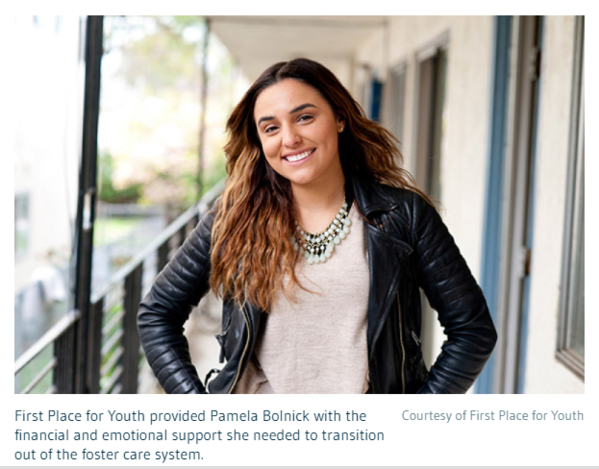Almost half of all foster care youth end up in jail within two years of aging out of the system. First Place for Youth has figured out a housing and support strategy to keep these young adults out from behind bars and living on their own.
Moments of stability were rare during Pamela Bolnick's childhood. She repeatedly witnessed her father beat her mother, a Venezuelan immigrant diagnosed with schizophrenia. Bolnick's mom eventually left her abusive spouse, fleeing to the Bay Area with her two kids. When she stopped taking her medication, the county child welfare department stepped in and placed six-year old Bolnick and her younger brother in foster care. Her mother resumed treatment for mental illness, and for two short years, retained custody of her children. After another relapse, Bolnick and her sibling were permanently removed from their home.
Bolnick was placed with her godparents in Richmond, Calif., an East Bay city then known for its notoriously high murder rates. Toughened by her childhood, she excelled at El Cerrito High School, impressing teachers in her Advanced Placement classes and filling her schedule with softball games and dance rehearsals. By senior year, however, she felt her foster family was pressuring her to move on. "All this time, I looked at them as being my own family. I did everything that you'd expect of a child, going to school, not getting into trouble, applying to college," Bolnick says, "I came to see it as a business transaction: them being paid (by the government) for taking care of me, and me getting the benefits of being a child in their custody." Disgusted, she left and spent the summer living at friend's house.
Each year in California, several thousand youth exit foster care immediately upon turning 21 years old. (Previously emancipated at 18, youth care was extended by a 2012 state law.) Longitudinal studies by researchers from University of Chicago's Chapin Hall Center for Children found that 24 percent of youth were homeless after exiting the system and nearly half had been incarcerated within two years. Perhaps most shockingly, 77 percent of the young women reported a pregnancy, risking another generation reentering the system.
Headquartered in Oakland, Calif., First Place for Youth provides emancipated youth in five Bay Area counties and Los Angeles with their very first apartment, covering both the security deposit and the monthly rental fees. Last year, 464 youth moved into their first residences. Most stay in the program for around 18 months; some kids drop in for 30 days, while others stay for three years, current First Place for Youth CEO Sam Cobb says. Before exiting, the organization assists the young adults meet four main goals: find stable employment, locate housing that matches their income, complete two semesters of community college or a certificate program and, finally, achieve "healthy living", which means avoiding arrests, unintended pregnancies and substance abuse.
Why was Bolnick able to beat the odds? Some of the latest scientific research on trauma might call it grit or resilience - an inborn ability to overcome. In her words, "I think it has to do with seeing the light behind all the blockages that get in the way. It takes a lot mentally," she explains. "If I keep telling myself that I am a foster kid, I am a Latina woman, I live in Richmond and all of my friends are doing the same things that people expect me to do, I should just as easily do that. But I never once had that thoughts at all. I just wanted to make the best of what I had." Bolnick also credits First Place for Youth for providing her with the network she needed to halt a situation that was spiraling out of control. She says the nonprofit gave her "stability, stability, stability."
To read the entire story written by Chris Peak originally appearing in Bridging the Opportunity Divide, please click here



Comments (0)